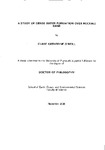A STUDY OF DENSE WATER FORMATION OVER ROCKALL BANK
| dc.contributor.author | O'NEILL, CLARE KATHERINE | |
| dc.contributor.other | School of Geography, Earth and Environmental Sciences | en_US |
| dc.date.accessioned | 2013-09-16T11:44:23Z | |
| dc.date.available | 2013-09-16T11:44:23Z | |
| dc.date.issued | 2008 | |
| dc.identifier | NOT AVAILABLE | en_US |
| dc.identifier.uri | http://hdl.handle.net/10026.1/1754 | |
| dc.description.abstract |
Rockall Bank is a large undersea bank situated in the north-east Atlantic. The region features steep bathymetry with the depth of Rockall Trough reaching 3000 m, rising to the surface at Rockall rock itself. Winter convective mixing in this area is strong and can reach 600 m or more. As this is deeper than a significant proportion of the bank, the water column above the bank becomes cooler than in the surrounding area, and a "cold water patch" forms. This water has been observed moving off the slope as a dense water cascade, a process that is important for shelf-ocean exchange and ventilation and which is also biologically important. This research contributes to knowledge of the dense water formation over Rockall Bank by analysing remotely-sensed data as well as numerical model results. Within this study: i) satellite sea surface temperature data were obtained for a ten year time series and the presence and properties of the surface cold water patch were investigated, and ii) the POLCOMS numerical model was adapted to simulate the Rockall Bank under different climatological conditions. It was demonstrated that a surface cold patch could be seen regularly in the satellite SST data, though more often there is a cold front associated with the Bank with no distinct cold patch. The duration of the cold patch and the duration of the front are inversely linked, and the cold patch is seen for longer in winters with a greater winter temperature difference across the Bank. The model successfully simulated the formation of the dense water in three test years, and the results show that the Bank greatly amplifies the effect of changing meteorological conditions. Dense water formation is very sensitive to changes in the winter air temperature, with a 2°C temperature decrease leading to a three-fold increase in the density difference between the water over the Bank and the surrounding area. The model results show a limited amount of cascading during the cooler years, but no cascading at all in the warmer year. Such large changes in the dense water formation caused by a relatively small change in air temperature suggests that climate change will have a significant impact on this system. | en_US |
| dc.language.iso | en | en_US |
| dc.publisher | University of Plymouth | en_US |
| dc.title | A STUDY OF DENSE WATER FORMATION OVER ROCKALL BANK | en_US |
| dc.type | Thesis | |
| plymouth.version | Full version | en_US |
| dc.identifier.doi | http://dx.doi.org/10.24382/3692 |
Files in this item
This item appears in the following Collection(s)
-
01 Research Theses Main Collection
Research Theses Main


